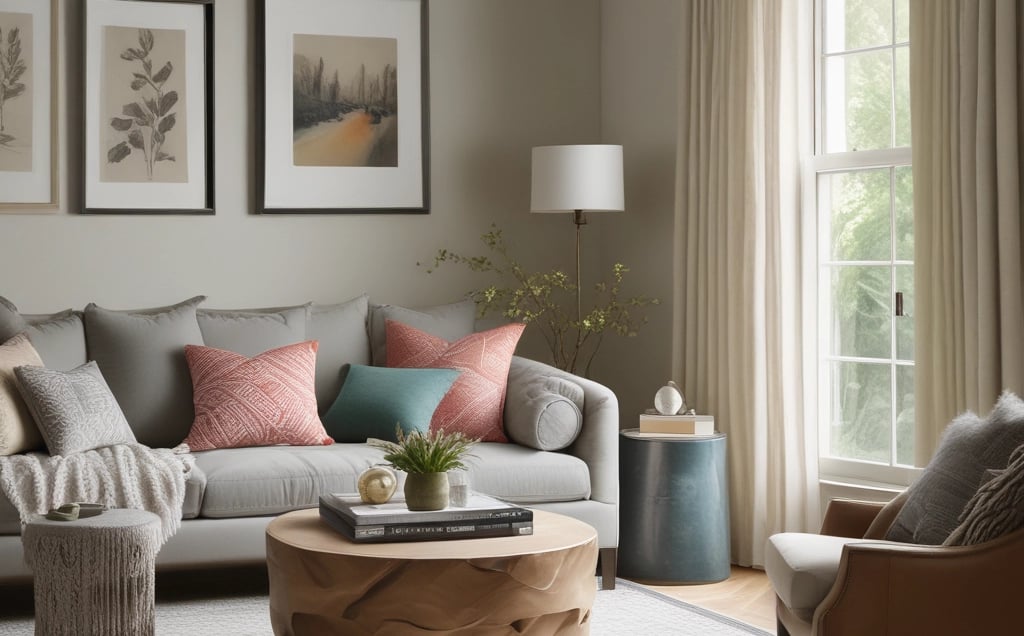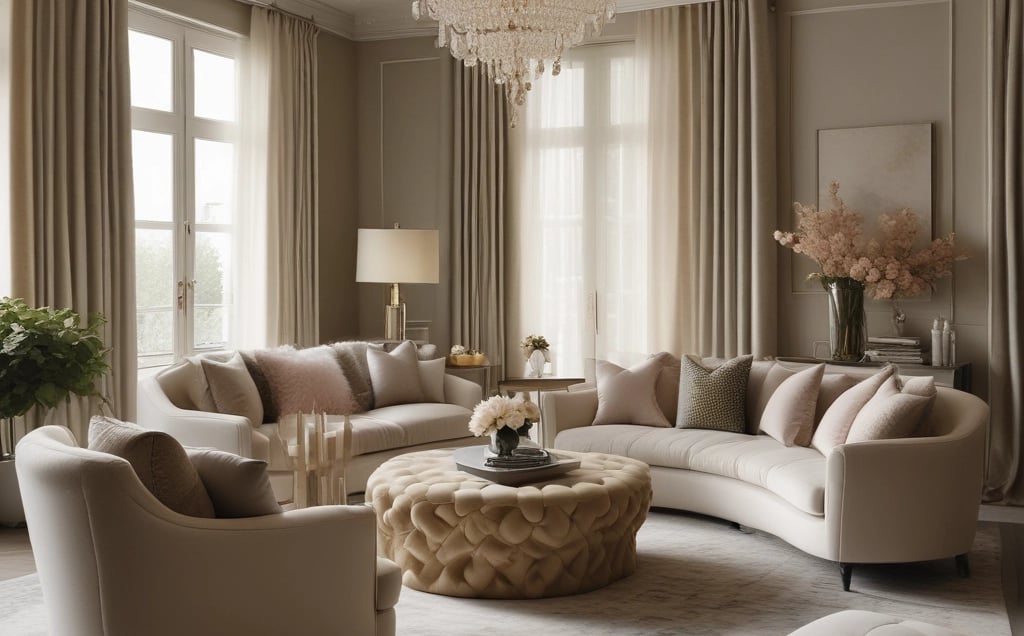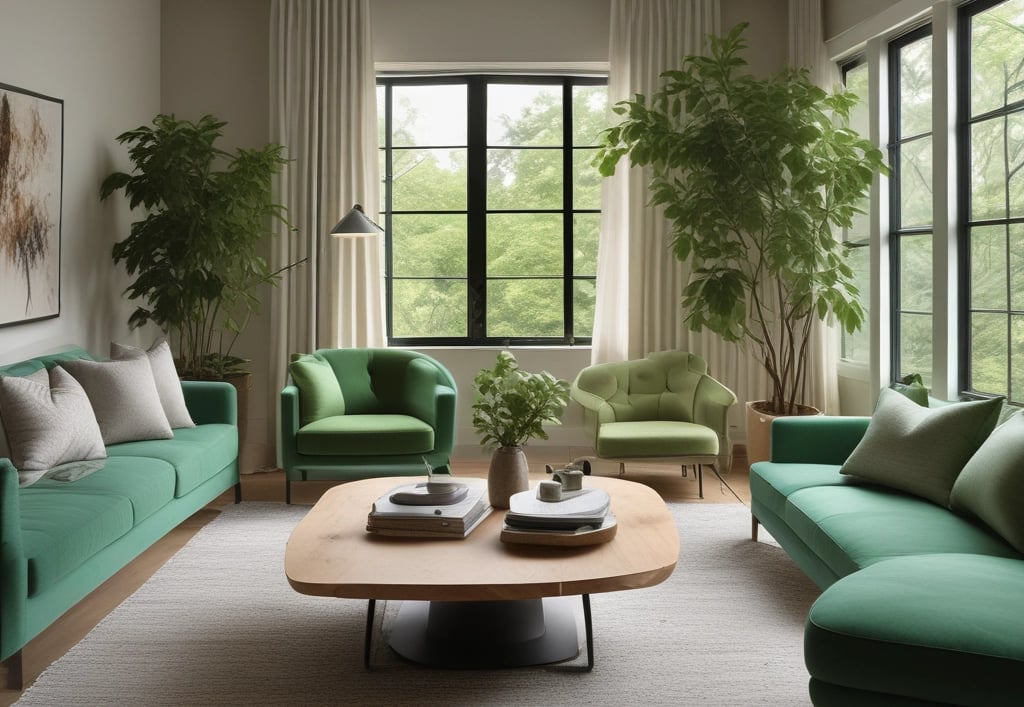The Impact of Fabrics on Style and Comfort in Interior Design
HOME DESIGN IDEAS
Mohamed Amine
10/20/20258 min read


The Power of Texture: Creating Depth and Warmth
In the realm of interior design, the significance of fabric texture should not be underestimated. The choice of materials can greatly influence the ambiance and overall aesthetic of a space. Fabrics such as velvet, linen, and cotton play critical roles in achieving a sense of depth and warmth, creating inviting environments that foster comfort and relaxation.
Velvet, with its luxuriously soft texture and rich appearance, adds an element of opulence to any setting. Its ability to reflect light creates an intriguing visual effect, enhancing the depth of the space. Incorporating velvet through upholstery, curtains, or decorative pillows can instantly elevate a room’s design, making it feel more sophisticated and cozy.
Linen, known for its breathable and lightweight nature, contributes to a casual and relaxed atmosphere. This fabric is particularly suited for contemporary designs where an effortless style is desired. Its natural fibers lend a tactile quality that adds warmth and texture, making spaces feel welcoming. The slight imperfections in linen can enhance its aesthetic appeal, creating a sense of authenticity in the design.
Cotton, another versatile and widely used fabric, provides comfort and durability while being easy to maintain. Its wide range of colors and patterns allows for extensive customization, permitting designers to play with textures and layering. Cotton can soften hard surfaces, balancing the overall visual composition in a room.
Case studies reveal that successful interior design often relies on a thoughtful mix of textures. Professionals frequently emphasize the importance of blending these fabrics to create contrast and interest. By experimenting with tactile elements, designers can achieve balanced environments that not only look appealing but also feel inviting.
Color, Pattern, and Personality in Fabric Selection
The selection of fabric in interior design extends beyond mere utility and comfort; it plays a crucial role in establishing the overall aesthetic and emotional tone of a space. Color schemes and patterns are key elements that reflect personal style, enhance interior environments, and evoke specific feelings. Understanding the psychological effects of color is essential for anyone looking to create a harmonious living space.
Color psychology suggests that different colors can influence moods and perceptions. For instance, warm colors like reds, oranges, and yellows often evoke feelings of warmth and energy, making them ideal for lively and inviting rooms such as kitchens or living areas. Conversely, cooler shades like blues and greens can promote calmness and relaxation, making them suitable for bedrooms and study spaces. By choosing fabrics in colors that resonate with personal preferences, individuals can enhance their sense of comfort and well-being within their homes.
Patterns also carry significant weight in fabric selection. Various prints, from bold geometric designs to delicate florals, serve to inject character and individuality into a space. Striking a balance between patterns and colors is vital; for example, large, busy patterns can be overwhelming in a small room, while subtle patterns can soften a minimalist design. Selecting the right patterns requires consideration of both the existing decor and the desired atmosphere. A well-chosen fabric can either complement or contrast with surrounding elements, contributing to a cohesive design narrative.
By thoughtfully integrating color and pattern into fabric choices, individuals can effectively convey their personality while ensuring that the space reflects their aesthetic values. The combination of these elements creates an emotional connection to the environment, ultimately enhancing the overall interior design experience. Emphasizing personal style while maintaining harmony with the room’s theme will lead to a beautifully designed living space.
Balancing Luxury and Functionality
In the realm of interior design, achieving a harmonious blend of luxury and functionality is an ongoing challenge faced by designers and homeowners alike. The allure of premium textiles, such as silk, velvet, and fine wool, often competes with the practical needs of everyday living. While these high-end fabrics can create a sophisticated ambiance and elevate the visual appeal of a space, their maintenance and durability are frequently concerns for those seeking lasting comfort.
To successfully balance these elements, it is essential to consider the intended use of each space. For instance, a living room intended for regular family gatherings may benefit from fabrics that withstand wear and tear such as synthetic blends or treated cotton while still providing a luxurious appearance. Microsuede and performance velvet serve as excellent examples of textiles that combine elegance with practicality. These materials not only offer the opulence reminiscent of traditional fabrics but are also designed to resist staining and fading, making them ideal for high-traffic areas.
When selecting fabrics for a specific area, it is beneficial to evaluate the lifestyle demands that will be placed upon them. Upholstery for family rooms or dining chairs should prioritize durability without compromising style. Adding layers with cushions or throws made from fine linen or cashmere can enhance the luxurious feel, while more robust underpinnings ensure longevity and easy maintenance. Furthermore, opting for fabrics with integrated stain-resistant technologies can significantly simplify care routines and extend the lifespan of the furnishings.
Ultimately, the goal is to create an inviting and stylish environment that remains functional. By thoughtfully selecting textiles that harmonize luxury with practical properties, one can cultivate spaces that exude sophistication while accommodating the rigors of daily life.
Upholstery Choices That Transform Spaces
The selection of upholstery fabrics plays a pivotal role in the overall aesthetics and comfort of interior spaces. It is through careful upholstery choices that one can achieve significant transformations, altering not only the appearance but also the ambiance within a room. Upholstery does not merely serve a functional purpose; it offers an opportunity to express personal style while enhancing comfort levels.
Different fabric types, textures, and patterns can evoke a variety of feelings and atmospheres. For instance, velvet upholstery can introduce a sense of luxury and richness, making it an ideal choice for formal sitting areas. Conversely, lighter fabrics such as linen or cotton can impart a casual, airy feel better suited for relaxed environments. By thoughtfully selecting the right upholstery, one can effectively redefine the space, ensuring that it mirrors the desired style and comfort level.
Case studies provide insightful examples of how upholstery fabric choice impacts overall design. For example, a living room that initially features a leather sofa might be reimagined with a soft, floral-patterned fabric. This shift not only softens the room’s tones but also encourages a more inviting, comfortable seating arrangement. Another case involves an office space where muted, patterned upholstery on chairs can promote a professional atmosphere while simultaneously creating a sense of warmth and approachability.
It is vital to consider the durability of upholstery as well, especially in high-traffic areas. Choosing fabrics that withstand wear and tear while providing comfort enhances the longevity of furniture. Moreover, sustainable fabric options have become increasingly popular, marrying style with eco-consciousness, which can also influence decision-making for eco-minded consumers.
In conclusion, the right upholstery fabric significantly impacts both aesthetic appeal and comfort in interior design, reflecting personal style preferences while fulfilling functional needs. Thoughtful choices can truly transform a space, leading to a harmonious blend of style and comfort.
The Role of Fabrics in Eco-Friendly Design
In recent years, the significance of sustainability has increasingly permeated the realm of interior design, particularly concerning fabric choices. Designers and homeowners alike are gravitating towards eco-friendly fabrics, recognizing their contribution to a greener and more sustainable living environment. These materials not only impact the aesthetic appeal of a space but also reflect a commitment to environmental responsibility.
Eco-friendly fabrics encompass a variety of materials that are either sustainably sourced or produced with minimal harm to the environment. Natural fibers such as organic cotton, linen, and hemp are excellent options, as they are biodegradable and often produced without harmful chemicals. Recycled materials, like reclaimed cotton or polyesters made from ocean plastics, provide innovative alternatives that effectively reduce waste and conserve resources. By choosing these fabrics, individuals can significantly decrease their carbon footprint while enhancing the style of their homes.
Incorporating sustainable fabrics into interior design enhances comfort and style without compromising environmental values. Besides their visual appeal, eco-friendly options are often available in various textures and colors, allowing for innovative and stylish design possibilities. Moreover, certifications such as Global Organic Textile Standard (GOTS) and OEKO-TEX provide assurances regarding the environmental integrity of textiles. When shopping for sustainable fabrics, consumers should look for these certifications to ensure their choices genuinely align with eco-friendly practices.
Ultimately, the role of fabrics in eco-friendly design extends beyond mere appearance; it embodies a holistic approach to living in harmony with the environment. By prioritizing sustainable fabrics, interior design can successfully marry comfort, style, and ecological consciousness, paving the way for a future that respects and nurtures the planet.
Layering Fabrics: Creating Visual Interest
Layering fabrics is an essential technique in interior design that significantly enhances both the visual interest and comfort of a space. By artfully combining different textures, colors, and patterns, designers can create a cohesive yet dynamic environment that reflects the homeowner's personal style. The core idea behind fabric layering is to add depth and dimension to interiors, transforming flat surfaces into inviting settings.
When starting the layering process, consider the varying textures of fabrics. Combining materials such as soft cotton, luxurious velvet, and rugged linen can create a rich tactile experience. For instance, a plush velvet sofa can be paired with a cotton throw and linen cushions, creating a harmonious mix that exudes comfort. Mixing textures not only adds visual interest but also enhances the sensory appeal of a room, inviting occupants to engage with their surroundings more deeply.
Color is another vital aspect of layered fabrics. A well-thought-out color palette can unify disparate elements while allowing creative expression. For example, a neutral base can be energized with vibrant accent pillows or a patterned area rug. Utilizing a consistent color theme helps maintain visual coherence, while strategically incorporating bold or contrasting colors can create focal points that draw the eye. It is essential to find a balance; overusing bright shades may overwhelm a space, while subtle hues could allow for a serene atmosphere.
Furthermore, the combination of patterns plays a crucial role in achieving a well-styled interior. When mixing patterns, it is beneficial to consider scale and placement to create a more sophisticated look. For instance, pairing large geometric patterns with smaller floral designs can provide visual contrast while ensuring the overall design remains cohesive. By following these layering techniques, one can achieve an inviting and stylish setting that comfortably reflects personal tastes.
Fabrics for Different Rooms: Tailoring Your Choices
Choosing the right fabrics for different rooms is essential for creating cohesive styles and enhancing comfort within a home. Each space has unique requirements, and understanding these can significantly influence your decorative decisions. In living rooms, where versatility is key, opt for durable fabrics such as cotton, linen, and polyester blends. These materials offer both comfort and resilience, making them suitable for spaces that frequently host guests or face daily wear and tear. Additionally, selecting patterns and colors that align with the overall aesthetic can elevate the room’s ambiance, whether opting for lively prints or soothing tones.
For bedrooms, the focus shifts to creating a serene environment conducive to relaxation and restful sleep. Fabrics such as cotton and bamboo are excellent choices due to their breathability and softness. Additionally, using textiles like velvet for drapes or decorative cushions can add a touch of elegance while providing warmth. It's crucial to consider hypoallergenic options for those who may be sensitive to allergens, as well as darker fabrics that can enhance privacy and block out unwanted light.
In dining areas, where aesthetics meet functionality, stain-resistant fabrics are paramount. Table linens made from treated cotton or polyester can withstand spills while maintaining an inviting atmosphere. Upholstered dining chairs may benefit from materials that blend style with practical wear resistance, such as microfiber. For bathrooms, moisture-resistant fabrics such as terrycloth or quick-drying materials for towels and shower curtains can create a spa-like feel while ensuring durability against humidity.
Ultimately, tailoring your fabric choices to the specific function and style of each room not only enhances aesthetic appeal but also promotes a sense of comfort and practicality throughout your home. The thoughtful integration of various textiles offers a balance between style and utility that can transform any living space into an inviting sanctuary.
References
Textile Style: The Art of Using Antique and Exotic Fabrics to Decorate Your Home
Author: by Caroline Clifton-Mogg
Link: Textile StyleDecorating with Fabric
Author: by Donna Lang
Link: Decorating with FabricFabric Projects and Creative Decorating Ideas
Author: by Mary Engelbreit , Vitta Poplar , Barbara Elliott Martin
Link: Fabric Projects and Creative Decorating Ideas




